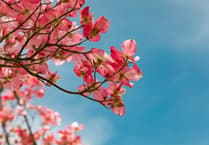‘Flaming June’ already. In work, most of the weather conditions are preceded by the word ‘flaming’ (or similar) – flaming rain, flaming wind, flaming sun and so on. After putting on and taking off various layers of clothing to try and keep up with the changing temperature one day last week, one of the boys was heard to mutter “God I hate weather.”
Even though most of us will associate the phrase ‘Flaming June’ with the weather, Flaming June is actually the title of Sir Frederic Leighton’s 1895 painting of a woman sleeping. She has flame-red hair and is in a fiery-orange dress but it is unclear whether June is her name, if the scene takes place during June, or whether the orange dress personifies warmth and sunshine. Interestingly it is also unclear if the toxic oleander branch in the top right corner symbolises the fragile difference between sleep and death. I was told, whilst living in the Caribbean, not to use oleander wood on a BBQ as even the smoke is toxic. These things are worth knowing.
The phrase ‘Flaming June’ somehow became synonymous with the month and its weather but in the UK June is often unsettled as a series of fronts – often called the European Monsoon - roll in from the Atlantic. Ironically, June is generally cooler and wetter than July and August – although as we well know the ‘weather lottery’ could throw up any balls! But thanks to a painting of a woman in an orange dress, June will always be associated with fiery, and tiring, summer heat.

I have no idea what weather June will bring but I do know that the seemingly-endless wet weather has resulted in huge numbers of slugs and snails. Using beer-traps, and putting planks on the ground to attract them overnight, and removing in the morning, seems to be the preferred methods of trying to keep numbers down. The best way I have ever witnessed was Duck Patrol at an organic nursery. Four characterful Indian Runner ducks were let into the veggie plot early every morning where they would have ‘slugs for breakfast’ before going back to their pen, full and contented.
Charles Dowding explains in his latest newsletter how No-Dig has been particularly useful in the recent months as the surface compost keeps the surface warmer by absorbing more infrared radiation – which it another good reason for heavily mulching beds and borders as well as veggie beds. He explains that weather stats can be misleading. Despite a grey May and rainfall 60% above average, the mean temperature was also above average because of warmer nights. But days were cooler and darker - with common cumulus clouds being darker than normal - and a definite lack of sunshine. Records show that in 10 years of recording radiation, or light levels, this spring has been the lowest by far.
As the soil has been continually damp (since last July more-or-less), it means that weeds can also germinate continually. So ‘keep weeding’ whatever your method – Charles is a fan of the hoe but I like to hand pull as much as I can. In a lot of the gardens I look after at the moment all I can do is ‘fire-fight’ as nature races into the lead. I am pulling nettles and bramble from shrubs, keeping the lawn edges neatly trimmed, staking and tying in and of course keeping the lawns mown – even if it is just mown paths. These few priorities will stop your plot looking neglected until nature ‘goes to seed’ and you can catch up.



